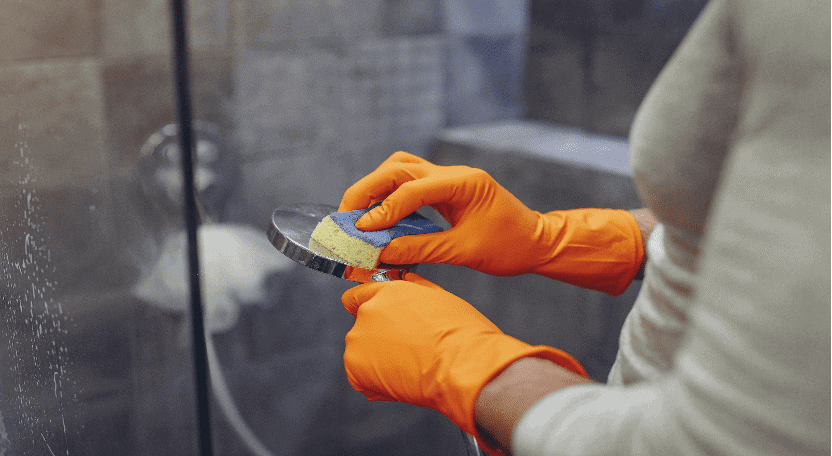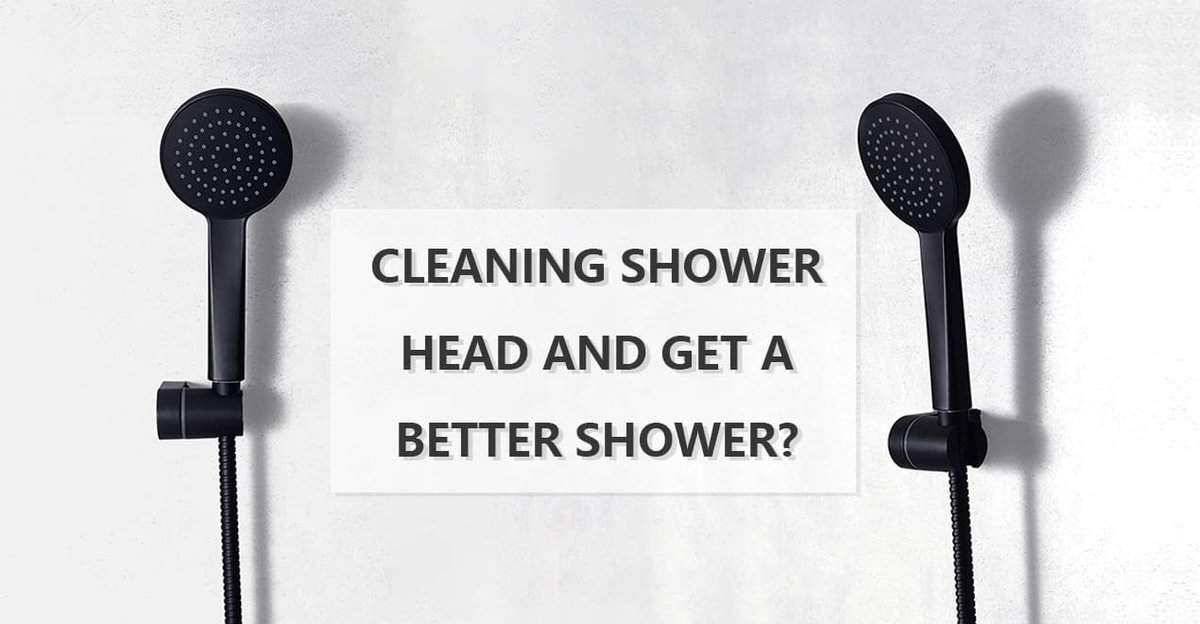New shower heads deliver a powerful blast of water through your shower in one direction. However, mineral deposits and dirt buildup clogs the nozzles, which causes water to sprout in different directions. So instead of getting a nice and relaxing blast of water from your shower, you end up having a frustrating experience. Don’t let your oh shower moment turn into a urgh.
How to Cleaning Shower Head?
Cleaning the shower head for a better shower experience includes scrubbing and soaking. The scrubbing technique involves scrubbing the shower head regularly to prevent limescale and grime buildup. The soaking method using distilled white vinegar, baking soda, and lemon juice, is effective for heavier buildup.
The Scrubbing Technique
The scrubbing technique is the most basic cleaning method we often use. You can do this to either stationary or handheld shower heads. You can do this once weekly, biweekly, or even monthly, depending on how often you deep clean your bathroom. It’s easy, quick, and simple.

Scrubbing the shower head and nozzles prevents potential mineral deposits and dirt buildup from accumulating even before they start to form. Using your preferred brand of cleaner and a small nylon-bristled scrubber, you can scrub your shower head clean, including the hard-to-reach areas.
Materials:
- Small Nylon-bristled Brush or Old Toothbrush
- Toothpick
- Bathroom Cleaner
- Rubber Hand Gloves
- Wrench or Locable Pliers
1. Remove the Shower Head
Carefully disassemble the shower head from its arm by turning its top section to the right unfastening direction. Some showerheads are designed to unlock by turning it clockwise, while others are counter-clockwise.
If it’s stuck, cover the top section with a clean rag, use a wrench or lockable pliers, and slowly unfasten it. The rag will protect the showerhead finish from scratches. Remember not to turn the showerhead itself, as it is designed to rotate. Doing so may damage its natural function.
In removing handheld showerheads, twist the shower arm off just a few inches from where the arm meets the flexible shower nozzle.

2. Clean the Rubber Nozzle
Minerals and calcium deposits clog the flexible rubber nozzles of the showerhead. Due to the blockage, limited water volume can pass through the tiny holes, compromising its performance and functions.
To clean the rubber nozzle, apply a generous amount of all-purpose bathroom cleaner and scrub the nozzles using the small nylon-bristled scrubber or an old toothbrush to remove accumulated dirt and limescale deposits.
You may use a toothpick and prick each nozzle hole to remove hard-to-reach clogs. Rinse with hot water to help soften and flush out the deposits. Repeat the process until all mineral and dirt buildup is gone.
3. Dismantle the Parts of your Shower Head
Now it’s time to give your shower head a deeper and more thorough cleaning. Put a towel on a table and dismantle your shower head on it. The towel keeps all parts intact, prevents them from rolling down, and protects the finish from scratches.
Although the large cone-shaped area of the showerhead does not come apart, the small ball joint section can be dismantled. Twist the back two sections found at the back of the showerhead to expose the gasket and filter screen.
4. Remove the Flow Control Filter Screen and Clean it.
Depending on your state, some areas have an implemented law regarding allowable showerhead flow rate; thus, flow constrictors are added to showerhead features. Before attempting to clean your constrictor, check your local government mandate first.
For showers with flow constrictor, you may need to use needle-nose pliers to it out. However, don’t force to take it out because some are designed as built-in and cant be detached.
Dip your scrubber in the bathroom cleaner and gently scrub the flow control screen. Let it sit under the flowing faucet water to rinse and remove the buildup.
5. Submerge the Shower Head Parts in Bathroom Cleaner
For better results, submerge the showerhead in bathroom cleaner for two minutes to soften the remaining dirt and mineral deposits. You may have cleaned the nozzle spray and the flow constrictor, but you have yet to reach the internal sections, especially the large cone-shaped section; thus, submerging it in bathroom cleaner will help loosen the dirt.
Add an equal amount of all-purpose bathroom cleaner and warm water in a plastic container. Let the showerhead submerge in the cleaning mixture for two minutes or more, depending on the severity of the buildup.
6. Clean and Scrub the Shower Head Parts
Remove the showerhead from the mixture, and scrub the reachable areas using the scrubber, especially the flow constrictor, screen, and gasket. Gently knock the showerhead into your palm to help mineral particles loosen and fall out.
7. Rinse and Reassemble
Thoroughly rinse the showerhead and its dismantled parts with cool, fresh water. Let it sit in the towel for a few minutes to dry. The towel will eventually absorb the excess moisture from the showerhead. You may also use a microfiber cloth or towel to pat the showerhead dry.
Before putting back the showerhead, wrap the water supply pipe with Teflon tape. Carefully reassemble the parts and screw to reconnect the shower head to its arm.
8. Test the Water Flow Quality
Now that the shower head is firmly reassembled back in place, turn on the shower to check the difference in water flow quality.
The Soaking Technique
Soaking requires submerging the showerhead in an acidic solution to loosen, dissolve, and remove mineral deposit buildup and hard water stains. This technique is suitable and highly recommended for badly clogged showerheads and if you want to give your showerheads a deep and thorough cleaning.
Acidic vinegar is the most common ingredient used in soaking because it’s cheap, non-toxic, and a natural cleaner. However, for severe mineral buildup, you may need to soak your showerheads for a day or two or even more.
If you’re in a hurry and don’t have the time to wait until all mineral buildup is dissolved, try a commercial cleaner designed to remove limescale and hard water stains on chrome-finished fixtures.
Cleaning Shower Head with Apple Cider or Distilled White Vinegar

Materials:
- A bottle of Apple Cider Vinegar/ Distilled Vinegar or White Vinegar
- Toothpick
- Mild All-purpose Bathroom Cleaner
- Towel
- Teflon Sealant Tape
- A Large Bowl
- Adjustable Wrench
- Baking Soda (optional only)
- Metal Polish (optional only)
1. Remove the Shower Head
Remove the showerhead from the shower arm by hand. This is the safest way to avoid creating scratches on its chrome finish. If it’s too tight, cover the upper section of the shower head with a rag or hand towel, then use an adjustable wrench or lockable pliers to unscrew the head from the arm.
2. Put the Disassembled Shower Head in a Large Bowl
Put the showerhead in a large bow with its nozzle positioned either side up or sideways. Ensure the bowl is large enough to submerge your shower head in the acidic solution. Slightly swirl the mixture to allow it to reach hard internal surfaces.
3. Sprinkle a Quarter Cup of Baking Soda into the Shower Head
This step is optional. If you want to maximize the cleaning power of your acidic solution, add baking soda. It helps loosen the mold, gunk, mineral buildup, and other growth, which is evident in the fizzing effect that happens once you add the acidic vinegar mixture.

4. Add an Equal Amount of Vinegar and Water to the Bowl
The acidic solution should have the same amount of vinegar as the water or one part vinegar and one part water. Vinegar is naturally acidic, so it’s best to dilute it first with water to avoid damaging the chrome finish in your showerhead.
Make sure that the solution is enough to submerge the entire shower head. You may use apple cider vinegar, distilled white vinegar, or plain white vinegar; whatever are available works just fine.
5. Let the Showerhead Soak in the Acidic Solution
Now, you’re probably wondering how many hours you should soak your shower head in the cleaning mixture. There’s no definite answer to that because it depends on the severity of mold, gunk, and mineral build-up that clogs your shower head. It could be a few hours or several hours; it’s up to you!
For slight buildups, you may soak your showerhead between 20-30 minutes. However, for severe cases, you can soak it between six to eight hours.
You also need to check the materials of your showerhead before deciding on the soak time. The acidity of vinegar may damage the coating of your showerhead if left soaked in the solution for a long period.
6. Remove the Shower Head from the Bowl
Once satisfied with the results, remove the shower head from the bowl. Rinse it under flowing faucet water.
7. Wash the Showerhead Using Mild Bathroom Cleaner
Wash the showerhead with mild all-purpose bathroom cleaner while inspecting the nozzles and swiping loose mineral buildup from the nozzle spray. Rinse it thoroughly.
Using a toothpick, prick each nozzle spray to remove loosened clogs. Rinse it and gently knock it off on the palm of your hand to remove deep-seated residue. Rinse thoroughly under running water and tap it dry using a towel.
8. Apply Metal Polish to Enhance the Look of your Showerhead
This is an optional step. You may apply a metal polish to improve the aesthetics of your showerhead and restore its natural finish. It also helps hide stubborn hard water stains. But you must be careful because the metal polish has a noxious scent covering up the solution’s vinegar smell.
9. Reassemble the Showerhead Back to its Arm
Before putting back the showerhead, wrap the water supply pipe with Teflon tape. Carefully reconnect the shower head to its arm.
10. Test the Water Flow Quality
Now that the shower head is firmly reassembled back in place, turn on the shower to check the difference in water flow quality.
How to Cleaning Shower head in Place Without Removing it
Materials:
- A bottle of Apple Cider Vinegar/ Distilled Vinegar/ White Vinegar
- Toothpick
- Mild All-purpose Bathroom Cleaner
- Towel
- Baking Soda (optional only)
- Metal Polish (optional only)
- Thick Rubber Band/Zip-tie/ Twist Tie/ Clip
- Large Zip-lock Bag/ Gallon-sized Plastic Bag
1. Mix the Acidic Solution in the Plastic Bag
Fill the Large zip lock bag or gallon-sized plastic bag with one part vinegar and one part water. The ratio between the two should be equal to minimize the acidity of the vinegar. You may also use lemon juice as an alternative to vinegar. You may also add baking soda to the solution to help loosen mineral deposits, mold growth, and soap scum.
2. Lift the Plastic Bag for a Showerhead Soak
Once the cleaning solution is well diluted in the plastic bag, lift the bag to ensure that the showerhead is completely submerged. Put a little less of the solution in the nag to avoid overspilling.
3. Seal the Plastic Bag by Tying a Rubber Band around the Shower Arm

Close the opening of the plastic bag by tying a large and thick rubber band around the closed opening of the plastic bag. Ensure it’s tightly wrapped around the shower arm to prevent the bag from slipping and spilling.
4. Let the Shower head Soak in the Solution
To remove severe calcium deposits and hard water buildup, you may need to soak your clogged showerhead for a few hours or several hours until all mineral deposits are loosened and dissolved.
The recommended time is from 20 minutes to six to eight hours. However, there’s no definite rule to follow. Remember that acidic solutions can damage your chrome, brass, and nickel coated shower heads and alter other showerhead finishes.
5. Remove the Plastic Bag and Rinse the Shower head
Remove the rubber tie and the plastic bag. Rinse the showerhead under running water. Use mild bathroom cleaner to remove the remaining traces of the cleaning solution from your showerhead. Rinse thoroughly. Turn the shower on and run hot water to flush the remaining loose debris. Tap dry using a microfiber cloth or towel.
In Summary
There are numerous ways to eliminate hard water debris, mineral buildup, and harmful mold and bacterial growth on showerheads. The most effective and non-toxic deep cleaning methods include scrubbing and soaking. Scrubbing includes cleaning the shower parts with a soft brush or an old toothbrush. The soaking process involves submerging the shower head in a liquid solution.
We don’t need to invest in expensive harsh cleaners to clean our home fixtures. Sometimes, the materials we have available at home are more than enough to deliver optimum results. Try cleaning your showerhead using these techniques, and witness the impressive results.
Do you have other needs, please follow our page to get more faucet cleaning and purchase strategy Oh!




